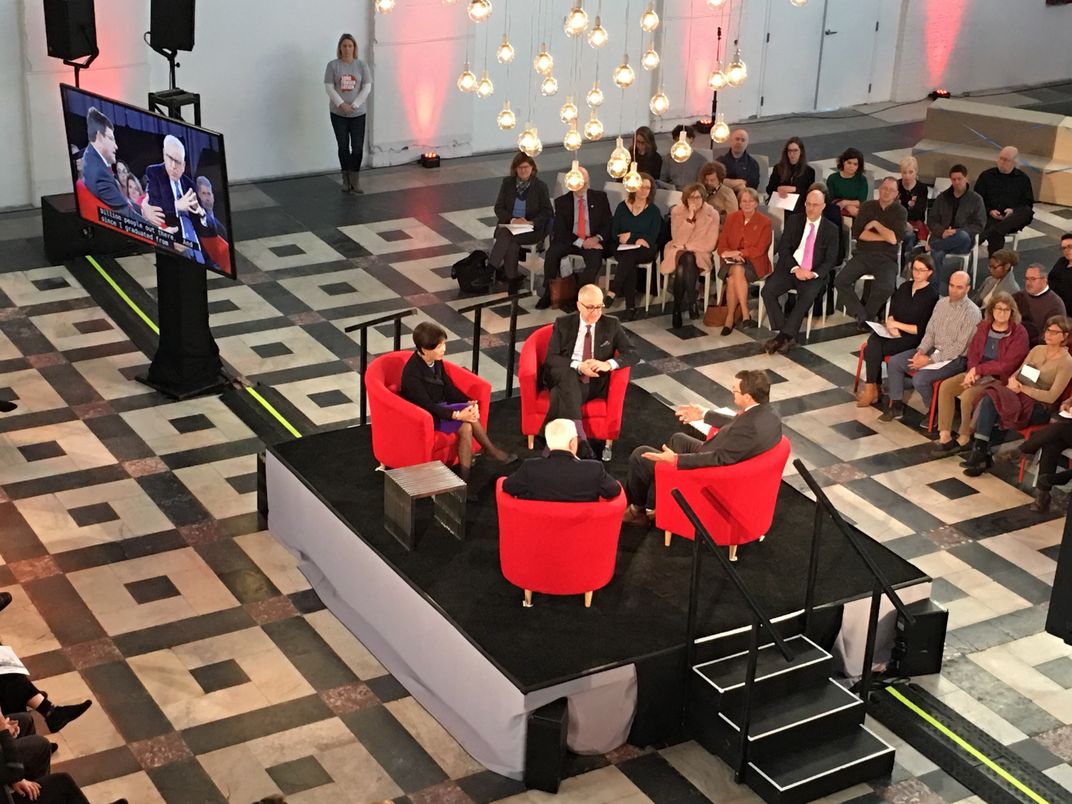Smithsonian Unveils a Bold New Action Plan, Grounded in Unity and Outreach
A fresh philosophy aims to touch the lives of a billion people every year
:focal(2016x1728:2017x1729)/https://tf-cmsv2-smithsonianmag-media.s3.amazonaws.com/filer/7b/3a/7b3a695a-26f7-44b1-b69e-e38d340b87d4/shortconv1.jpg)
For nearly 200 years, the Smithsonian Institution has served as a cultural and educational beacon for the sprawling United States, never straying from its foundational mission to effect the “increase and diffusion of knowledge.” Its museums in Washington, D.C. and New York City draw millions of visitors annually, and its vast artifact collections are the subject of continual research efforts.
Yet, say the Smithsonian's leaders, there is room for improvement. The various museums have succeeded in cultivating their individual identities across the years, but a sense of cohesion is missing, the linkages between the different arms of the organization often unclear. And though the Institution has tapped into the realm of the digital, there is no doubt that more can be done online to reach a wider audience.
These concerns were the impetus for the drafting of a new Smithsonian strategic plan, which sets out a half-dozen interrelated goals designed to strengthen and democratize the work of the Institution as it moves towards its 175th anniversary in 2021 and beyond.
David Skorton, secretary of the Smithsonian Institution, delved into the philosophy underpinning this new blueprint earlier this afternoon, in a publicly live-streamed conversation also featuring congresswoman Doris Matsui, Natural History Museum director Kirk Johnson and Smithsonian Board of Regents chair David Rubenstein.
One of the catalyzing principles outlined in the plan is Goal 1: “Be One Smithsonian.” The idea of “One Smithsonian” is to bolster the conceptual and logistical infrastructure connecting museums and research efforts across the Institution.
As director of Smithsonian exhibits Susan Ades put it in a staff meeting earlier this week, “We need to stop retreating to our corners, to our siloes, to our individual units, and act together as one institution.” This has been attempted less forcefully before, and Ades is wary of what she calls the “eye-roll factor”—employees throwing up their hands and saying, “Been there, tried that.” In her mind, as in Skorton’s, the One Smithsonian concept is not only doable, but key to expanding the Smithsonian’s footprint across the board.
“On a philosophical level,” Ades says, “it would change our culture to be one about communication and collaboration, where people could see themselves as stronger together than apart. And at a tactical, practical level, it should make it easier to get done all the things that we need to get done.”
Recent displays of pan-Smithsonian solidarity—such as when employees from all across the various Smithsonian buildings on the National Mall flocked to the African American History Museum to offer their support following the discovery of a noose in one of the exhibition spaces—hearten Ades, Skorton and the other overseers of the new plan. Growing this solidarity over the coming years seems a practicable vision; at a baseline level, they say, all it requires is a mutual willingness to reach out.
Another standout goal on the new list is more concrete in nature: “Reach One Billion People a Year with a Digital-First Strategy.” From a purely numerical standpoint, achieving this goal within five years poses a major challenge. But in the eyes of Skorton, and Effie Kapsalis, who is chief of content and communications strategy at the Smithsonian Institution Archives, the lofty target will provide a much-needed jolt to the Smithsonian’s efforts to create a distinct and wide-reaching digital presence.
Kapsalis stresses that the Smithsonian’s online “audience” should really be viewed as a user base—its members are active participants in discussion, not idle bystanders. The Smithsonian, she says, should be receptive to the public’s response to its work. “We have a lot of two-way interactions online,” she says. “We spend a lot of time learning what people are doing online.” The key going forward will be embracing these interactions more openly, and leveraging the knowledge gleaned to reach additional eyes and ears.

Some 30 million visitors accessed the Smithsonian’s museums in 2017, but to Skorton, that’s the tip of the iceberg in the digital age. “We’re here to reach far beyond those fortunate enough to come across our thresholds,” he said in the conversation today.
“We are the holders of our country’s icons,” added Kirk Johnson. Johnson is eagerly awaiting the day when the “deep knowledge in these buildings gets unleashed online” fully. Representative Matsui was equally enthusiastic. “This new strategic plan that pushes everything out is wonderful,” she said. She is looking forward to seeing a true forum crystallize online, where “difficult conversations can be had in a digital manner.”
The other goals, including “Catalyze New Conversations and Address Complex Challenges” and “Understand and Impact 21st Century Audiences,” expand on the core themes of creating a Smithsonian that feels more like one organism and allowing that organism to reach out online to form meaningful bonds with users across the country and world.
More than anything, the new strategic plan aims to preserve for future generations the spirit of wonder at the Smithsonian, says Johnson, who still remembers when he told someone that he worked for Smithsonian and drew an audible gasp.
“When you work here a long time,” Johnson says, “you forget the fact that people gasp when you say the word ‘Smithsonian.’ We could make people gasp globally.”
/https://tf-cmsv2-smithsonianmag-media.s3.amazonaws.com/accounts/headshot/DSC_02399_copy.jpg)
/https://tf-cmsv2-smithsonianmag-media.s3.amazonaws.com/accounts/headshot/DSC_02399_copy.jpg)